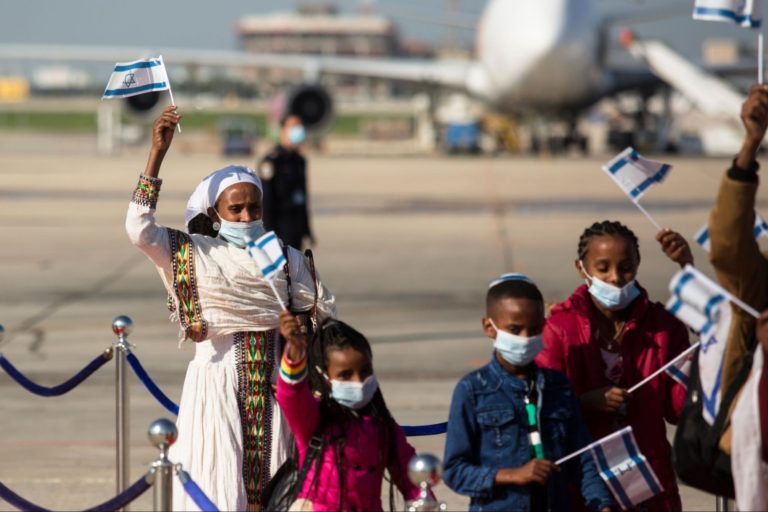
Listen to this article:
This week marks the 30th anniversary of Operation Solomon, the famous Israeli airlift that brought more than 14,000 Ethiopian Jews to Israel in less than 36 hours (on May 24 – May 25, 1991). What is the story of the Ethiopian Jewish community, and why did Israel carry out this operation? And why does Operation Solomon matter to Israel today?
What was Operation Solomon?
Let’s start from the beginning. The Jewish community of Ethiopia — known in Hebrew as the “Beta Israel” (or “community of Israel”) — lived in complete isolation from the rest of the Jewish world for more than 2,000 years. The first Beta Israel are thought to have emigrated from ancient Israel to Ethiopia. Historian Anita Shapira explains: “According to their own legend, they are the progeny of Jews from the Land of Israel who went down to Ethiopia with the Queen of Sheba and her son Menelik, who was sired by King Solomon and became emperor of Ethiopia. Some hold that the first Jews came to Ethiopia after the destruction of the First Temple.”
The Ethiopian Jewish community (like other Jewish communities around the world) prayed for almost 2,000 years to return to the Land of Israel. Starting in the 1980s, that dream became a reality for thousands of Ethiopian Jews. A civil war and widespread famine had broken out in Ethiopia, leading to an increase in the persecution the Jewish community was already facing. Hoping to escape the war and move to Israel, 12,000 Ethiopian Jews trekked by foot through the country’s desert to Sudan. 4,000 of them lost their lives from malnutrition, disease and violence along the way. Once they reached Sudan, they were prevented from proceeding to Israel due to pressure from Arab countries and were placed in refugee camps where they faced antisemitic persecution.
At this time, Israel had been sending Mossad agents to coordinate small airlifts of Ethiopian Jews to Israel. In 1984, with the cooperation of the Sudanese government and the CIA, Israel initiated Operation Moses, secretly airlifting 8,000 Ethiopian Jews from Sudan to Israel in just seven weeks. Unfortunately, Operation Moses ended prematurely when Sudan’s Arab allies found out about the airlift and pressured Sudan to cut off the operation. Thousands of Ethiopian Jews remained in war-torn Ethiopia in danger of losing their lives. In 1991, a regime change in Ethiopia provided an opportunity for the Israeli government to act. In May 1991, Operation Solomon brought more than 14,000 Beta Israel to Israel in under 36 hours. Through these two operations, Israel’s Ethiopian population went from a few hundred in 1983 to over 20,000 in 1991.
Today, about 125,000 Ethiopian Jews live in Israel, with 100 to 300 Ethiopian immigrants arriving in Israel each month. However, about 5,000 people known as Falash Mura or Falashas — Jews whose ancestors converted, under duress, to Christianity — remain in Ethiopia. Falash Mura means “strangers” or “migrants” in Amharic (the official language of Ethiopia). They were given this derogatory name because Beta Israel did not consider them authentic Jews after they converted. In October 2020, the Israeli government approved the aliyah of 2,000 Falash Mura; the last of this group of immigrants arrived in Israel earlier this year.
Challenges in Transitioning To Life in Israel
With the miraculous operations of Moses and Solomon, the Ethiopian Jewish community had finally fulfilled their centuries-long dream to return to the Land of Israel. However, the community’s transition into Israeli society presented new challenges.
Historian Shapira explains the Ethiopian Jewish community’s complicated relationship with Zionism and Israel: “The trek to Sudan … in the course of which many hundreds died, and its stories of heroism form the basis of the Ethiopians’ identity as Zionists and Israelis… But their identification with Israel was full of problems because of a profound sense of otherness that deepened in reaction to the host society’s reservations.”
“They came with nothing, they didn’t know the language, the culture and it was very difficult for them to express themselves for what they need,” said Roni Akale, director-general of the Ethiopian National Project.
In preparation for the absorption of tens of thousands of Ethiopian Jews, the Israeli government developed an elaborate program covering issues of housing, education and employment. However, this approach did not sufficiently account for social and cultural differences between the existing Israeli population and incoming Ethiopian immigrants.
Unlike European immigrants, Ethiopians were coming from rural villages, and were not prepared to work and live in a modern, industrialized society. This led to social and economic marginalization of the Ethiopian immigrant community.
Making matters worse, not all Israelis supported the aliyah of the Ethiopian Jewish community. The new Ethiopian immigrants also faced religious challenges in Israel. Although their Jewish status had been affirmed in 1973 by the Chief Sephardi Rabbi of Israel Ovadia Yosef, many Israelis continued to question whether Ethiopian Jews were really Jewish.
Ethiopian Jews are not the only community that has faced challenges transitioning into modern Israeli life. Jews from North Africa and other parts of the Middle East, Holocaust survivors, and Soviet Jews have also faced particular obstacles in integrating into Israeli society. Of course, learning a new language, leaving behind family and friends, and starting a new life in a different culture are challenges that many immigrants experience around the world.
Operation Solomon was 30 years ago, one of the biggest rescue operations in #Israel's history. From May 24-25, 1991, over 14,000 Ethiopian Jews were rescued and brought to Israel, in a mission that took just 36 hours.
— WJC (@WorldJewishCong) May 23, 2021
Israel forever remains committed to bringing Jews to safety. pic.twitter.com/HANWB4zKDe
Ethiopian-Israeli Life Today: Successes and Continued Challenges
Although integration into Israeli society has been slow, many aspects of life for Ethiopian-Israelis have improved since the community first arrived in the Jewish state. In May 2020, Pnina Tamano-Shata of the Blue and White party became the first Ethiopian to serve as a minister in the Israeli government. In 2012, Israel appointed the country’s first Ethiopian-born ambassador, Beylanesh Zevadia.
“In 30-40 years, we now have doctors, we have lawyers, we have judges, we have ambassadors, we have officers in the Israeli Army,” said Akale. “So most of the young generation of the Ethiopian community can say that we are involved in Israeli society in the right direction.”
Ethiopian-Israelis have also risen through the ranks of the military. In December 2018, an Ethiopian-Israeli soldier became the Israeli Air Force’s first pilot of Ethiopian heritage. And in 2016, Dr. Avraham Yitzhak became the first Israeli of Ethiopian heritage to hold the rank of colonel in the IDF. The Ethiopian music scene has also been attracting greater attention in Israel. In February 2020, the singer Eden Alene was selected as the first Israeli of Ethiopian descent chosen to represent Israel at the Eurovision Song Contest, and advanced to the finals of the contest for her performance of the song “Set Me Free.” The popular Idan Raichel Project — a group led by the singer Idan Raichel which features Ethiopian musicians — has also helped bring Ethiopian music into the Israeli mainstream.
Despite this progress, the Ethiopian-Israeli community still faces discrimination, and full integration is far from complete. The Israeli government has worked to improve the quality of housing, reduce unemployment and combat racism in the workplace and at large. However, poverty, a lack of opportunity, in some instances police brutality and other forms of discrimination persist as issues for this community. Organizations such as the Ethiopian National Project, the Israel Association for Ethiopian Jews and Be’chol Lashon work to ensure the full integration of Ethiopian immigrants into Israeli society and raise awareness about Ethiopian Jewry. The recent, government-approved aliyah of 2,000 members of the Falash Mura community is a testament to this work and improving attitudes toward Ethiopians in Israel.
“Imagine the challenges this community must face when they come,” said Grace Rodnitzki, director of international relations of the Ethiopian National Project. “The only way you could describe it in Israel was this absolute euphoria and this outpouring of everybody wanting to help. What initially started as a cultural gap ended up becoming … a socioeconomic gap and all those negative socioeconomic trends are a direct response of that initial cultural gap.”
Why This Matters
Operation Solomon is an inspiring example of how Israel followed through on its promise to be a homeland for all the Jewish people. It shows just how far the state of Israel has gone to take responsibility for Jews around the world. Israel’s Declaration of Independence underscores the idea of kibbutz galuyot (the ingathering of exiles) as a central mission of the Jewish state: “The state of Israel will be open for Jewish immigration and for the ingathering of the exiles (kibbutz galuyot).” In carrying out Operations Moses and Solomon — and by passing the Law of Return (which grants Jews around the world automatic citizenship if they move to Israel) — Israel put these aspirational ideals into practice regardless of race, beliefs or culture. For the Ethiopian Jewish community, these operations made possible the fulfillment of a centuries-long dream to return to their ancient homeland.
The realization of “kibbutz galuyot” is one of the crowning achievements of Zionism, but as the story of the Ethiopian-Israeli community shows, the work is not yet complete. Like every other country in the world, Israel has more work to do to address the challenges its new immigrants face. This work is a critical part of the Zionist vision: Israel’s Declaration of Independence speaks not only of a commitment to Jewish immigration, but also of the Jewish state’s values of equality and acceptance of others. As Professor Gil Troy reminds us, Zionism involves the constant effort to continue improving Israeli society, “starting with Israel’s unfulfilled promises of full equality to Arabs, Ethiopians, Mizrachim, the poor.”
“The children have a motivation: they want to learn, they want to educate themselves, they want to be like other Israelis,” said Akale.
The Bottom Line
With all the recent turmoil, the violence, the riots, the rockets, and the devastating images, Jewish identity across the world has been challenged. The story of Operation Solomon is the story we can all call upon in times of distress like this. It was the opposite of Jew vs. Jew. It was Jew with Jew. Regardless of having different traditions, different races, and in many cases different histories, the story of Operation Solomon reminds us that the Jewish people share the same destiny. And while Israel is certainly not a finished product, the integration of Jewish people from all races, faiths, backgrounds and socio-economic statuses, as well as the integration of all of Israel’s citizens regardless of religion or culture has always been and will always be what the people of Israel want to accomplish.
Originally Published May 25, 2021 12:04AM EDT


